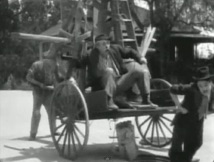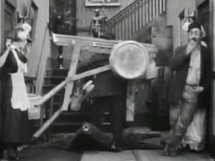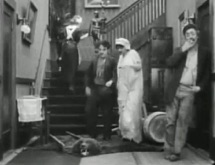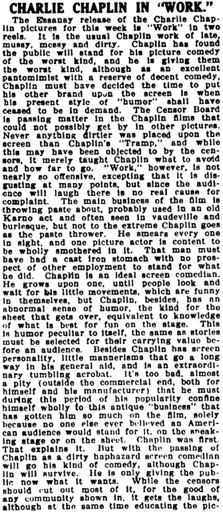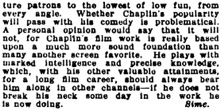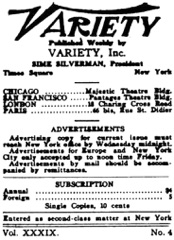Work Clippings 33/85
Sime Silverman, Variety, New York, June 25, 1915.
Work Scenes
& Sime Silverman
(...) Photo, Variety, Dec. 10, 1910
& VARIETY
Published Weekly by
Variety, Inc.
Sime Silverman, President
(...) Variety, June 25, 1915
„If he does not break his neck“
Editorial content. „CHARLIE CHAPLIN IN ,WORK.‘
The Essanay release of the Charlie Chaplin picture
for this week is Work in two reels. It is the usual
Chaplin work of late, mussy, messy and dirty. Chaplin has
found the public will stand for his picture comedy
of the worst kind, although as an excellent pantomimist
with a reserve of decent comedy, Chaplin must
have decided the time to put his other brand upon the screen
is when his present style of ,humor‘ shall have
ceased to be in demand. The Censor Board is passing
matter in the Chaplin films that could not possibly
get by in other pictures. Never anything dirtier was placed
upon the screen than Chaplin‘s Tramp, and while
this may have been objected to by the censors, it merely
taught Chaplin what to avoid and how far to go.
Work, however, is not nearly so offensive, excepting that it is
disgusting at many points, but since the audience
will laugh there is no real cause for complaint. The main
business of the film is throwing paste about,
probably used in an old Karno act and often seen
in vaudeville and burlesque, but not to the
extreme Chaplin goes as the paste thrower. He smears every
one in sight, and one picture actor is content to be
wholly smothered in it. That man must have had a cast iron
stomach with no prospect of other employment to
stand for what he did. Chaplin is an ideal screen comedian.
He grows upon one, until people look and wait for
his little movements, which are funny in themselves, but
Chaplin, besides, has an abnormal sense of humor,
the kind for the sheet that gets over, equivalent to knowledge
of what is best for fun on the stage. This is humor
peculiar to itself, the same as stories must be selected for
their carrying value before an audience. Besides
Chaplin has screen personality, little mannerisms that go a long
way in his general aid, and is an extraordinary tumbling
acrobat. It‘s too bad, almost a pity (outside the commercial end,
both for himself and his manufacturer) that he must
during this period of his popularity confine himself wholly to this
antique ,business‘ that has gotten him so much on the
film, solely because no one else ever believed an American
audience would stand for it, on the sneaking stage
or on the sheet. Chaplin was first. That explains it. But with
the passing of Chaplin as dirty haphazard screen
comedian will go his kind of comedy, although Chaplin will survive.
He is only giving the public now what it wants. While
the censors should cut out most of it, for the good of any
community shown in, it gets the laughs, although
at the same time educating the picture patrons to the lowest
of low fun, from every angle. Whether Chaplin‘s
popularity will pass with his comedy is problematical.
A personal opinion would say that it will not, for
Chaplin‘s film work is really based upon much more sound
foundation than many another screen favorite.
He plays with marked intelligence and precise knowledge,
which, with his other valuable attainments, for a long
film career, should always bear him along in other channels –
if he does not break his neck some day in the work
he is now doing. Sime.“
Redaktioneller Inhalt

